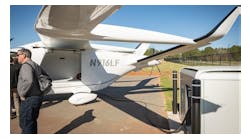KCI Airport Runway Improvement Project Approaches Crossroads
The Runway 1R-19L rehabilitation project at Kansas City International Airport has advanced to phase two. The north/south runway intersects with the east/west Runway 9-27. Runway names correlate with compass headings, deleting the zero at the end.
Since the two runways meet, the intersection needs to be closed for pavement demolition and replacement. The runway intersection will be closed on July 11, and the intersecting Runway 9-27 will be closed for 90 days, essentially closing two of the airport’s three runways. Since the airport will be down to one operating runway, the work will be on a fast track to ensure all runways will be open by winter. No airline delays are expected during the closure.
In August 2015, the Aviation Department received a $20-million Federal Aviation Administration Airport Improvement Program Grant. The Aviation Department will receive reimbursement from this grant for 75 percent of the costs for the engineering and construction of the project. The contract with Ideker, Inc. Construction Co. has totaled at $25.4 million, with work beginning on May 2.
“The investment we and the FAA are making in improving the airfield is imperative to our airport, as it is at other US airports,” said Pat Klein, director of aviation. “Renovations to KCI’s runway infrastructure will ensure that we can continue to meet increases in demand with a safe, secure and efficient airfield.”
The project requires the removal and replacement of 17-inch thick Portland Cement Concrete pavement from the southern 3,500 feet of the 9,500-foot long runway. The northern 6,000 feet of Runway 1R-19L was replaced last year. The project also includes the restoration of the concrete pavement on Runway 9-27 where it intersects with Runway 1R-19L, as well as the parallel taxiways that intersect the two runways.
Phase two of the project was initiated by the destruction and removal of the 20-year-old concrete surface of the runway using heavy machinery, including a 29,000-pound oblong drum that, when towed, has the ability to break the pavement of the runways quickly and efficiently to the full 17-inch depth. Front end loaders pry up loosened concrete and load it into trucks where the materials are relocated to improve on-airport drainage and terrain stabilization.
Some of the concrete rubble from Runway 1R-19L will be recycled into rip rap for the Berlin Reservoir, the large body of water along the airport’s entry road. Rip rap is loose rock that is used to form a protective foundation along the shore of a pond or lake. In order to comply with the required wildlife management program, the rip rap will line the banks of the pond, helping control the bird population around the airport by preventing the nesting of waterfowl.
In total, 31 acres of concrete pavement will be removed and replaced using granite-rock base in the cement mix for a “harder” wearing surface which could last up to 30 to 35 years. More than 900 new light in-pavement fixtures will be also be replaced.
The intersection construction is expected to be completed by October 11, 2016 in order to reopen Runway 9-27. The work on Runway 1R-19L will continue until December 2016.


